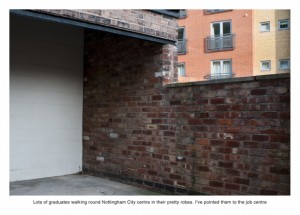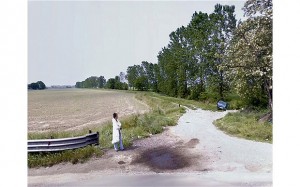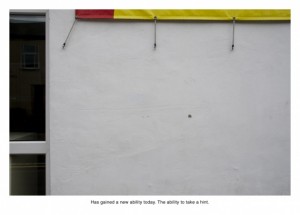Documentary Photography meets Google Street View and Twitter

Lots of graduates walking around Nottingham City centre in their pretty robes. I’ve pointed them to the job center.
Two recent shows in Portland featured artists incorporating twitter and Google photographic images, and one exhibition affirmed that traditional photojournalism is just as crucial a practice as ever.
Blue Sky Gallery in Portland, also known as the Oregon Center for the Photographic Arts, showed “No Man’s Land” by Mishka Henner and “Geolocations, Graduates Walking Round” a project by Nate Larson and Marni Shindelman. The first impact of both of these shows is that they are intentionally mirroring the twin realities of pervasive triviality and loss of privacy.
Mishka Henner’s work, based on stills from Google Street View cameras started from reading online male forums discussing the locations of local sex workers, Henner found the locations on Google Street View and downloaded the image of the women there ( with no confirmation that they were actually sex workers) . The women are consistently far away from the camera, photographed from a moving car with a high vantage point, and their faces are blurred out. We have no relationship with them, other than a distant drive by view (elaborated in the accompanying video in the exhibition providing the complete footage of the drive by).
“Geolocations, Graduates Walking Round” was trivial in a different way. Based on Tweets with location coordinates, the artists photographed the location, then paired the tweet with the image. The image seemed inconsequential (like the Tweet), but sometimes, as here, amusing.
I was offended by Mishka Henner’s work, his depersonalized representations of unidentified supposed sex workers. As a privileged male artist, he seemed to be condescending, trite, and exploitative. Many others have pointed this out as well, some even calling for the suppression of Henner’s book. In no case does he identify any of the women or provide any context what so ever for them as sex workers, or the sex worker industry. He simply assumes the position of Google Street View and prints up frames as his copyrighted photography.
His defense of the works is that he feels that eliciting sympathy is “romantic” and a cheap shot, the impersonal view is more contemporary, depersonalized surveillance is what is happening on the planet. He also points out that the subject is a traditional topic for photography, so he is playing off of that history with his work.
He fails completely in my opinion to arouse any response what so ever except that he is an arrogant white guy. He is the real subject of these photographs. There are many artists expropriating images from Google Street View these days, for many purposes. All of them are working with the issue of surveillance, originality, authorship in the age of Google Street View. Miska Henner’s work, because of his topic, becomes simply traditional voyeurism and cruising.
The second exhibition “Geolocations, Graduates Walking Round’ became less mundane in comparison to the work of Mishka Henner. Knowing that these images were actually taken by the photographers, subtle details began to emerge, as well as an intriguingly serendipitous relationship between their triviality as subject, and the triviality of the tweet. They had an abstract, formal quality, an amusing reinvention of modernist aesthetics based on utterly uninteresting subjects – an anti-utopian, heroic impact that completely contradicts the principles of high modernism, even as they have strong modernist references in their compositions.
But poetic absurdity is the main theme. Photographs as locations based on the tweets are actually arbitrarily chosen. Coordinates give 360 degrees of possibilities. The artists selected which way to look, and the direction they chose is tangentially related to the tweet itself, not exactly visually, but in the sense of a certain blankness or dead end f1uality.
My favorite example was “Has gained a new ability today, ability to take a hint.” Here. the three lines dangling from a tarp and the single dot, with the window to the left obviously are a play on Mondrian, and is matched with the tweet. That single dot in the center, that diagonal tie down, could it be we can see Mondrian taking a hint? The modernist aesthetic was cleverly undermined.
Then I went to a third exhibition at the I witness gallery in the Northwest Center for Photography. The photojournalist Leah Nash spent more than a year with five people diagnosed with Asperger’s Syndrome. Four of them are featured in photographs in “A Different Kind of Normal: Stories of Asperger’s Syndrome” and one, a dancer, mother of two, in a video.
We see these people as individuals who are living their lives according to who they are and what they like and what they want to do. They are remarkable photographs and remarkable people. I felt a sense of relief to see these straightforward images, they were not eliciting pity or romance, as Henner so dismissively characterizes traditional photojournalism, they were eliciting respect and even some awe at these individuals. The photographer emphasizes them as people with feelings of love, joy, discouragement, and exhaustion, as well as close relationships with members of their families.
A statement in the show stated that Asperger’s Syndrome as a subset of Autism is being eliminated as a diagnosis. There is no comment on that fact, but if you think that this diagnosis gave all of these people a distinct identity, one can’t help but wonder what the result of taking that terminology away will have on them. Now they will simply be identified as autistic, a diagnosis that includes a broad range of different types of behavior and a diagnosis that is expanding exponentially, from 1 in 10,000 in the 1970s to 1 in 110 today. Asperger’s Syndrome has been defined as “high functioning autism.”
Leah Nash’s photographs not only educated me about Asperger’s Syndrome, they also made me think about the way that people define themselves, the way that society defines them, and how those two interact or contradict one another.
Mishka Henner claimed he did not want people to feel in response to his photographs, he wanted them to think. But the thinking he generated did not really stimulate any larger insights into society, humanity, or the state of the world. It stopped at the cliché that Google Street View is invasive and pervasive.
Nate Larson and Marni Shindelman fall in the middle. Their photographs are intentionally undramatic (although they are aesthetically constructed) , and they make a point about individuals risk of ( desire for?) public exposure (in the tweet, in the location), but they also exist as an act on the part of the photographers to wed those two media in a way that provided some provocative partnerships and a wonderful send up of the modernist aesthetic.
All of these exhibitions point to the fact that documentary photography is in transition as a result of new technologies, but Leah Nash’s work suggests that engaging with individuals is still an indispensable dimension of photography.
This entry was posted on June 9, 2012 and is filed under Photography.












